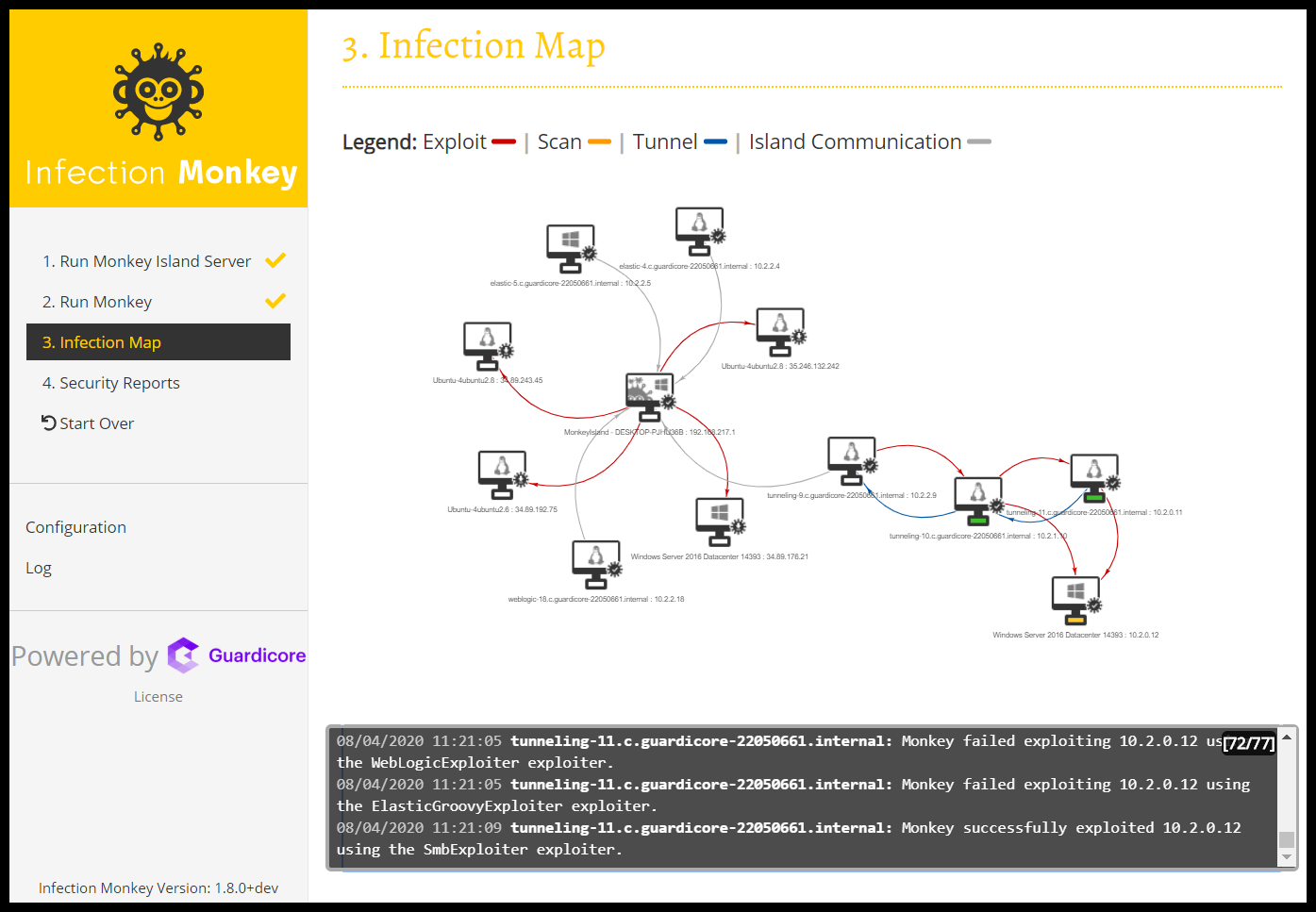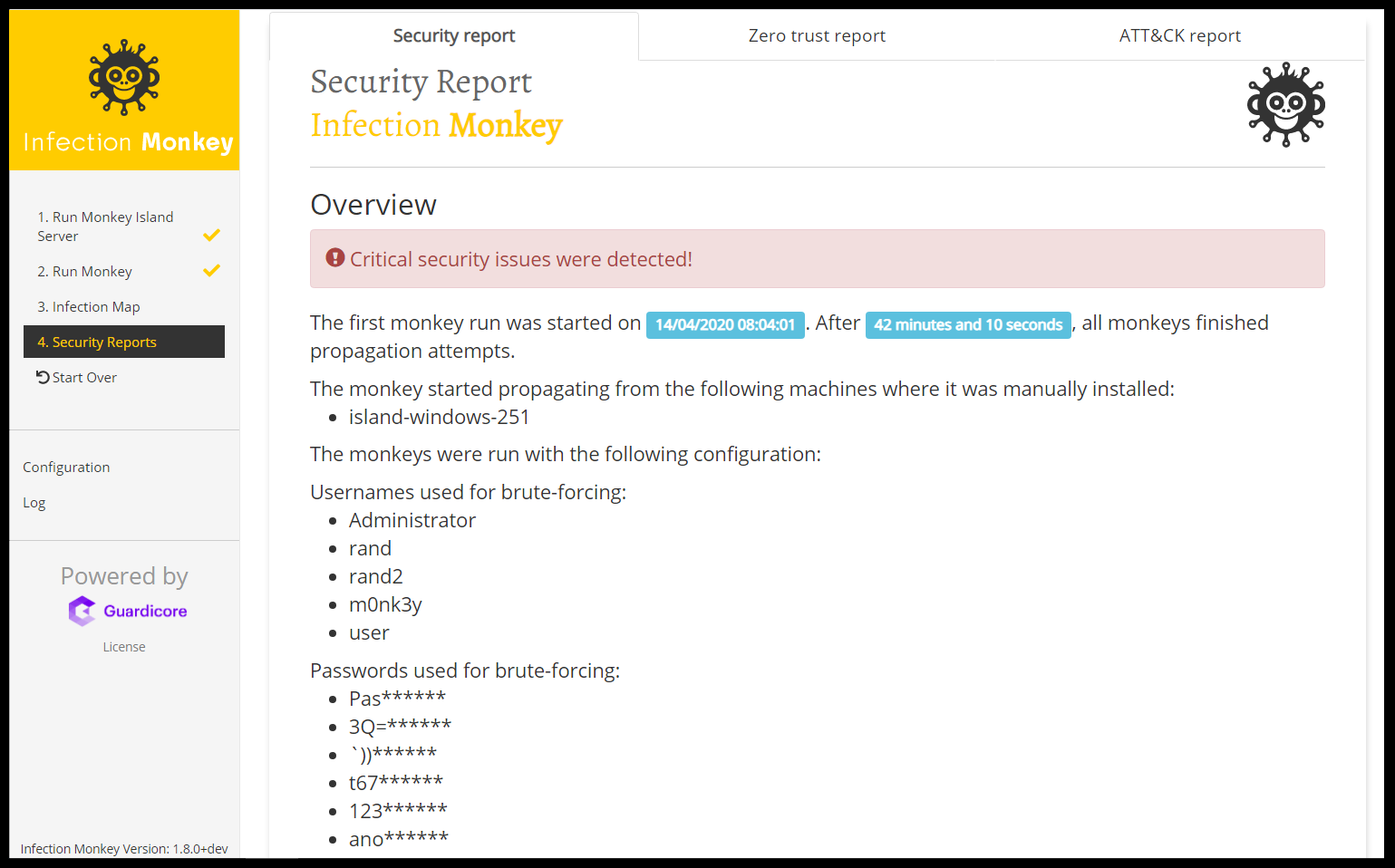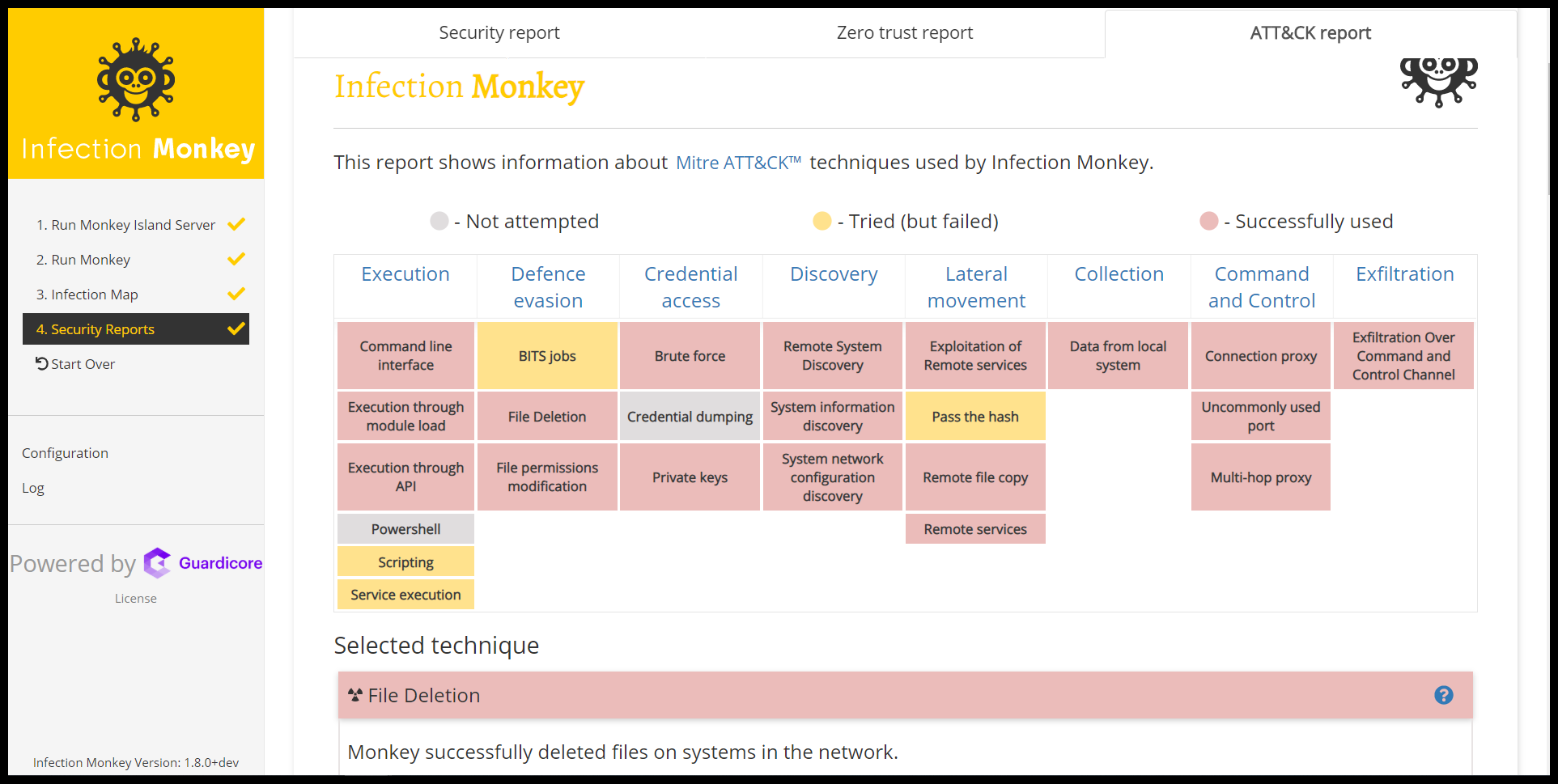# Infection Monkey
[](https://github.com/guardicore/monkey/releases)
[](https://travis-ci.com/guardicore/monkey)
[](https://codecov.io/gh/guardicore/monkey)


## Data center Security Testing Tool
Welcome to the Infection Monkey!
The Infection Monkey is an open source security tool for testing a data center's resiliency to perimeter breaches and internal server infection. The Monkey uses various methods to self propagate across a data center and reports success to a centralized Monkey Island server.
The Infection Monkey is comprised of two parts:
* **Monkey** - A tool which infects other machines and propagates to them.
* **Monkey Island** - A dedicated server to control and visualize the Infection Monkey's progress inside the data center.
To read more about the Monkey, visit [infectionmonkey.com](https://infectionmonkey.com).
## Screenshots
### Map
 ### Security report
### Security report
 ### Zero trust report
### Zero trust report
 ### ATT&CK report
### ATT&CK report
 ## Main Features
The Infection Monkey uses the following techniques and exploits to propagate to other machines.
* Multiple propagation techniques:
* Predefined passwords
* Common logical exploits
* Password stealing using Mimikatz
* Multiple exploit methods:
* SSH
* SMB
* WMI
* Shellshock
* Conficker
* SambaCry
* Elastic Search (CVE-2015-1427)
* Weblogic server
* and more
## Setup
Check out the [Setup](https://www.guardicore.com/infectionmonkey/docs/setup/) page in the Wiki or a quick getting [started guide](https://www.guardicore.com/infectionmonkey/docs/usage/getting-started/).
The Infection Monkey supports a variety of platforms, documented [in the documentation framework](https://www.guardicore.com/infectionmonkey/docs/reference/operating_systems_support/).
## Building the Monkey from source
To deploy development version of monkey you should refer to readme in the [deployment scripts](deployment_scripts)
folder or follow documentation in [documentation hub](https://www.guardicore.com/infectionmonkey/docs/development/setup-development-environment/).
### Build status
| Branch | Status |
| ------ | :----: |
| Develop | [](https://travis-ci.com/guardicore/monkey) |
| Master | [](https://travis-ci.com/guardicore/monkey) |
## Tests
### Unit Tests
In order to run all of the Unit Tests, run the command `python -m pytest` in the `monkey` directory.
To get a coverage report, first make sure the `coverage` package is installed using `pip install coverage`. Run the command
`coverage run -m unittest` in the `monkey` directory and then `coverage html`. The coverage report can be found in
`htmlcov.index`.
### Blackbox tests
In order to run the Blackbox tests, refer to `envs/monkey_zoo/blackbox/README.md`.
# License
Copyright (c) Guardicore Ltd
See the [LICENSE](LICENSE) file for license rights and limitations (GPLv3).
## Main Features
The Infection Monkey uses the following techniques and exploits to propagate to other machines.
* Multiple propagation techniques:
* Predefined passwords
* Common logical exploits
* Password stealing using Mimikatz
* Multiple exploit methods:
* SSH
* SMB
* WMI
* Shellshock
* Conficker
* SambaCry
* Elastic Search (CVE-2015-1427)
* Weblogic server
* and more
## Setup
Check out the [Setup](https://www.guardicore.com/infectionmonkey/docs/setup/) page in the Wiki or a quick getting [started guide](https://www.guardicore.com/infectionmonkey/docs/usage/getting-started/).
The Infection Monkey supports a variety of platforms, documented [in the documentation framework](https://www.guardicore.com/infectionmonkey/docs/reference/operating_systems_support/).
## Building the Monkey from source
To deploy development version of monkey you should refer to readme in the [deployment scripts](deployment_scripts)
folder or follow documentation in [documentation hub](https://www.guardicore.com/infectionmonkey/docs/development/setup-development-environment/).
### Build status
| Branch | Status |
| ------ | :----: |
| Develop | [](https://travis-ci.com/guardicore/monkey) |
| Master | [](https://travis-ci.com/guardicore/monkey) |
## Tests
### Unit Tests
In order to run all of the Unit Tests, run the command `python -m pytest` in the `monkey` directory.
To get a coverage report, first make sure the `coverage` package is installed using `pip install coverage`. Run the command
`coverage run -m unittest` in the `monkey` directory and then `coverage html`. The coverage report can be found in
`htmlcov.index`.
### Blackbox tests
In order to run the Blackbox tests, refer to `envs/monkey_zoo/blackbox/README.md`.
# License
Copyright (c) Guardicore Ltd
See the [LICENSE](LICENSE) file for license rights and limitations (GPLv3).
 ### Security report
### Security report
 ### Zero trust report
### Zero trust report
 ### ATT&CK report
### ATT&CK report
 ## Main Features
The Infection Monkey uses the following techniques and exploits to propagate to other machines.
* Multiple propagation techniques:
* Predefined passwords
* Common logical exploits
* Password stealing using Mimikatz
* Multiple exploit methods:
* SSH
* SMB
* WMI
* Shellshock
* Conficker
* SambaCry
* Elastic Search (CVE-2015-1427)
* Weblogic server
* and more
## Setup
Check out the [Setup](https://www.guardicore.com/infectionmonkey/docs/setup/) page in the Wiki or a quick getting [started guide](https://www.guardicore.com/infectionmonkey/docs/usage/getting-started/).
The Infection Monkey supports a variety of platforms, documented [in the documentation framework](https://www.guardicore.com/infectionmonkey/docs/reference/operating_systems_support/).
## Building the Monkey from source
To deploy development version of monkey you should refer to readme in the [deployment scripts](deployment_scripts)
folder or follow documentation in [documentation hub](https://www.guardicore.com/infectionmonkey/docs/development/setup-development-environment/).
### Build status
| Branch | Status |
| ------ | :----: |
| Develop | [](https://travis-ci.com/guardicore/monkey) |
| Master | [](https://travis-ci.com/guardicore/monkey) |
## Tests
### Unit Tests
In order to run all of the Unit Tests, run the command `python -m pytest` in the `monkey` directory.
To get a coverage report, first make sure the `coverage` package is installed using `pip install coverage`. Run the command
`coverage run -m unittest` in the `monkey` directory and then `coverage html`. The coverage report can be found in
`htmlcov.index`.
### Blackbox tests
In order to run the Blackbox tests, refer to `envs/monkey_zoo/blackbox/README.md`.
# License
Copyright (c) Guardicore Ltd
See the [LICENSE](LICENSE) file for license rights and limitations (GPLv3).
## Main Features
The Infection Monkey uses the following techniques and exploits to propagate to other machines.
* Multiple propagation techniques:
* Predefined passwords
* Common logical exploits
* Password stealing using Mimikatz
* Multiple exploit methods:
* SSH
* SMB
* WMI
* Shellshock
* Conficker
* SambaCry
* Elastic Search (CVE-2015-1427)
* Weblogic server
* and more
## Setup
Check out the [Setup](https://www.guardicore.com/infectionmonkey/docs/setup/) page in the Wiki or a quick getting [started guide](https://www.guardicore.com/infectionmonkey/docs/usage/getting-started/).
The Infection Monkey supports a variety of platforms, documented [in the documentation framework](https://www.guardicore.com/infectionmonkey/docs/reference/operating_systems_support/).
## Building the Monkey from source
To deploy development version of monkey you should refer to readme in the [deployment scripts](deployment_scripts)
folder or follow documentation in [documentation hub](https://www.guardicore.com/infectionmonkey/docs/development/setup-development-environment/).
### Build status
| Branch | Status |
| ------ | :----: |
| Develop | [](https://travis-ci.com/guardicore/monkey) |
| Master | [](https://travis-ci.com/guardicore/monkey) |
## Tests
### Unit Tests
In order to run all of the Unit Tests, run the command `python -m pytest` in the `monkey` directory.
To get a coverage report, first make sure the `coverage` package is installed using `pip install coverage`. Run the command
`coverage run -m unittest` in the `monkey` directory and then `coverage html`. The coverage report can be found in
`htmlcov.index`.
### Blackbox tests
In order to run the Blackbox tests, refer to `envs/monkey_zoo/blackbox/README.md`.
# License
Copyright (c) Guardicore Ltd
See the [LICENSE](LICENSE) file for license rights and limitations (GPLv3).